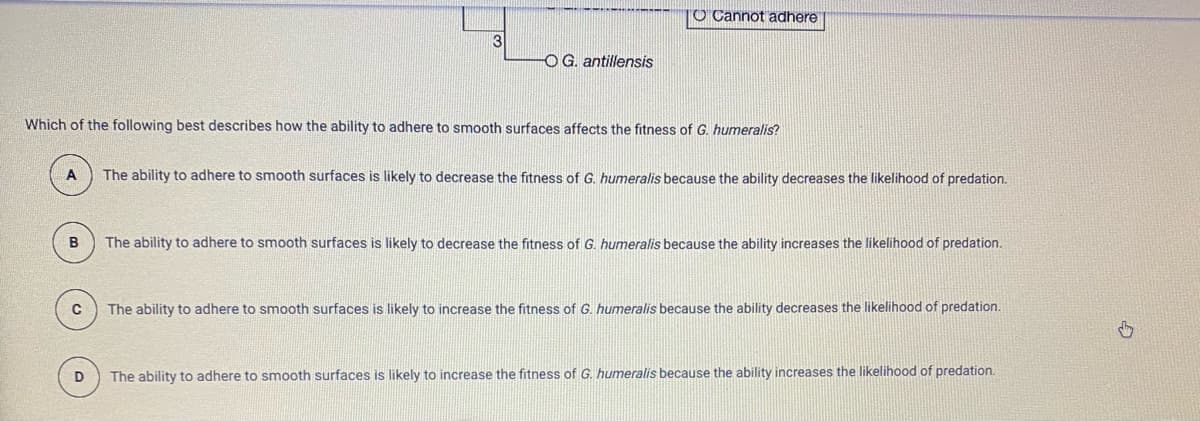Which of the following best describes how the ability to adhere to smooth surfaces affects the fitness of G. humeralis? A The ability to adhere to smooth surfaces is likely to decrease the fitness of G. humeralis because the ability decreases the likelihood of predation. The ability to adhere to smooth surfaces is likely to decrease the fitness of G. humeralis because the ability increases the likelihood of predation. C The ability to adhere to smooth surfaces is likely to increase the fitness of G. humeralis because the ability decreases the likelihood of predation. The ability to adhere to smooth surfaces is likely to increase the fitness of G. humeralis because the ability increases the likelihood of predation.
Which of the following best describes how the ability to adhere to smooth surfaces affects the fitness of G. humeralis? A The ability to adhere to smooth surfaces is likely to decrease the fitness of G. humeralis because the ability decreases the likelihood of predation. The ability to adhere to smooth surfaces is likely to decrease the fitness of G. humeralis because the ability increases the likelihood of predation. C The ability to adhere to smooth surfaces is likely to increase the fitness of G. humeralis because the ability decreases the likelihood of predation. The ability to adhere to smooth surfaces is likely to increase the fitness of G. humeralis because the ability increases the likelihood of predation.
Human Anatomy & Physiology (11th Edition)
11th Edition
ISBN:9780134580999
Author:Elaine N. Marieb, Katja N. Hoehn
Publisher:Elaine N. Marieb, Katja N. Hoehn
Chapter1: The Human Body: An Orientation
Section: Chapter Questions
Problem 1RQ: The correct sequence of levels forming the structural hierarchy is A. (a) organ, organ system,...
Related questions
Question

Transcribed Image Text:1O Cannot adhere
3
O G. antillensis
Which of the following best describes how the ability to adhere to smooth surfaces affects the fitness of G. humeralis?
A
The ability to adhere to smooth surfaces is likely to decrease the fitness of G. humeralis because the ability decreases the likelihood of predation.
B
The ability to adhere to smooth surfaces is likely to decrease the fitness of G. humeralis because the ability increases the likelihood of predation.
The ability to adhere to smooth surfaces is likely to increase the fitness of G. humeralis because the ability decreases the likelihood of predation.
D
The ability to adhere to smooth surfaces is likely to increase the fitness of G. humeralis because the ability increases the likelihood of predation.

Transcribed Image Text:The presence of tiny hairs, called setae, on the toe pads of some geckos is associated with the ability to adhere to smooth surfaces. This ability allows geckos to climb in areas where
many predators cannot. Scientists studying the evolution of setae have identified three closely related species of gecko, only one of which can adhere to smooth surfaces. A model of the
evolutionary relatedness between these species is represented in the figure.
G. humeralis
Can adhere
O G. concinnatus
O Cannot adhere
3
O G. antillensis
Which of the following best describes how the ability to adhere to smooth surfaces affects the fitness of G. humeralis?
The ability to adhere to smooth surfaces is likely to decrease the fitness of G. humeralis because the ability decreases the likelihood of predation.
Expert Solution
This question has been solved!
Explore an expertly crafted, step-by-step solution for a thorough understanding of key concepts.
This is a popular solution!
Trending now
This is a popular solution!
Step by step
Solved in 2 steps with 1 images

Knowledge Booster
Learn more about
Need a deep-dive on the concept behind this application? Look no further. Learn more about this topic, biology and related others by exploring similar questions and additional content below.Recommended textbooks for you

Human Anatomy & Physiology (11th Edition)
Biology
ISBN:
9780134580999
Author:
Elaine N. Marieb, Katja N. Hoehn
Publisher:
PEARSON

Biology 2e
Biology
ISBN:
9781947172517
Author:
Matthew Douglas, Jung Choi, Mary Ann Clark
Publisher:
OpenStax

Anatomy & Physiology
Biology
ISBN:
9781259398629
Author:
McKinley, Michael P., O'loughlin, Valerie Dean, Bidle, Theresa Stouter
Publisher:
Mcgraw Hill Education,

Human Anatomy & Physiology (11th Edition)
Biology
ISBN:
9780134580999
Author:
Elaine N. Marieb, Katja N. Hoehn
Publisher:
PEARSON

Biology 2e
Biology
ISBN:
9781947172517
Author:
Matthew Douglas, Jung Choi, Mary Ann Clark
Publisher:
OpenStax

Anatomy & Physiology
Biology
ISBN:
9781259398629
Author:
McKinley, Michael P., O'loughlin, Valerie Dean, Bidle, Theresa Stouter
Publisher:
Mcgraw Hill Education,

Molecular Biology of the Cell (Sixth Edition)
Biology
ISBN:
9780815344322
Author:
Bruce Alberts, Alexander D. Johnson, Julian Lewis, David Morgan, Martin Raff, Keith Roberts, Peter Walter
Publisher:
W. W. Norton & Company

Laboratory Manual For Human Anatomy & Physiology
Biology
ISBN:
9781260159363
Author:
Martin, Terry R., Prentice-craver, Cynthia
Publisher:
McGraw-Hill Publishing Co.

Inquiry Into Life (16th Edition)
Biology
ISBN:
9781260231700
Author:
Sylvia S. Mader, Michael Windelspecht
Publisher:
McGraw Hill Education